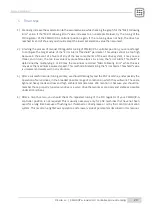
www.cs-lab.eu
CS-Lab s.c. | CSMIO/IP-A 6-axis CNC controller. Manual tunning
11
Step 15
Step 16
Step 17
Description of "kVff" term tuning:
Step 1 – 4
We increase the "kVff" by 0.05, the value of "Mkit Following Error" decreases.
Step 5
Further increasing the "kVff" value by 0.05 causes the "Mkit Following Error" value changes sign to
the opposite. It means that an axis overtook the set position (false start effect).
Step 6
We reduce the "kVff" value by 0,05, and we additionally reduce a value of Val/Div to 0,05 to enlarge
(enhance) the waveform.
Step 7 – 10
We increase the "kVff" value by 0.01, the value of "Mkit Following Error" decreases.
Step 11
We reduce the Val/Div to the value of 0,01 to enlarge the waveform.
Step 12 - 15
We increase the "kVff" by 0.001, the value of "Mkit Following Error" decreases.
Step 16
Further increasing of the "kVff" value by 0.001 causes the "Mkit Following Error" value changes sign
to the opposite. It means that the axis reached the set position but overtook it (false start effect).
Step 17
We reduce the "kVff" value by 0.0005, which aligns the waveform's left and right part.
We consider the current value of "kVff" as the target value, and we go to a next stage.
Please notice that the "Mkit Following Error" value in the discussed case is currently only 0,04mm (Val /
Div = 0,01mm x 4 oscilloscope grids). This proves that the "Feed forward" of velocity strongly supports
the work of the proportional term of the PID regulator.






































